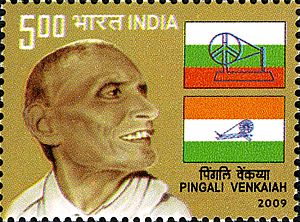Pingali Venkayya facts for kids
Quick facts for kids
Pingali Venkayya
|
|
|---|---|

Venkayya on a 2009 stamp of India
|
|
| Born | 2 August 1876/8 |
| Died | 4 July 1963 (aged 84 or 86) India
|
| Other names | Diamond Venkayya Patti Venkayya |
| Known for | Design of Indian National Flag |
| Spouse(s) | Rukminamma |
Pingali Venkayya (born August 2, 1876 or 1878 – died July 4, 1963) was an important Indian freedom fighter. He followed the ideas of Mahatma Gandhi. Venkayya is best known for designing the flag that became the basis for the Indian National Flag. He was also a teacher, writer, geologist, and farmer. He could speak many languages, making him a polyglot.
When he was 19, Venkayya joined the British Indian Army. He went to South Africa during the Second Boer War (1899–1902). There, he saw soldiers saluting the British flag. This made him realize that Indians needed their own flag. In 1906, he attended a big meeting in Calcutta. He felt inspired to create a flag for the Indian National Congress. He did not like the idea of using the British flag at Indian meetings.
Many different flags were used by Indians fighting for freedom before 1947. Pingali Venkayya designed a special flag. He showed it to Mahatma Gandhi on April 1, 1921, in Vijayawada. Venkayya's first flag design had red and green stripes. Red stood for Hindus, and green for Muslims. Gandhi suggested adding a white stripe. This white stripe would represent all other religions and groups in India. From 1921, Venkayya's flag was used unofficially at Congress meetings. The flag was officially adopted on July 22, 1947. This happened at a meeting of the Constituent Assembly.
Venkayya was also a farmer and an educator. He started a school in Machilipatnam. He passed away in 1963 and was not very well-known at the time. In 2009, a postage stamp was made to honor him. His name was suggested for the Bharat Ratna award in 2012. This is India's highest civilian award.
Contents
Early Life and Inspiration
Pingali Venkayya was born into a Telugu Brahmin family. This was on August 2, 1876, or 1878. His birthplace was Bhatlapenumarru, near Machilipatnam, in what is now Andhra Pradesh, India. His parents were Hanumantha Rayudu and Venkata Ratnam. He went to Hindu High School in Machilipatnam. He also spent his childhood in places like Yarlagadda and Pedakallepalli. He married Rukminamma, from Pamarru village.
At 19, he joined the British Indian Army. He served in South Africa during the Second Boer War (1899–1902). It was there that he first met Mahatma Gandhi. During the war, soldiers had to salute the Union Jack, the British flag. This experience made Venkayya understand how important it was for Indians to have their own flag.
A Man of Many Talents
Venkayya earned a diploma in Geology from the Madras Presidency College. From 1911 to 1944, he taught at the Andhra National College in Machilipatnam. He also studied mica in Nellore from 1924 to 1944. He wrote a book about geology called 'Thalli Raayi'.
People called Venkayya 'Diamond Venkayya'. This was because he knew a lot about diamond mining. He was also known as 'Patti Venkayya' (Cotton Venkayya). He spent much time studying different kinds of cotton. He did a detailed study on a type called Cambodia Cotton. Venkayya could speak many languages, including Japanese and Urdu. In 1913, he gave a full speech in Japanese at a school in Bapatla. After this, he was also called 'Japan Venkayya'.
Designing India's Flag
In 1906, Venkayya attended a meeting of the All India Congress Committee (AICC). This meeting was in Calcutta and led by Dadabhai Naoroji. Venkayya felt strongly that India needed its own flag. He did not want the British flag to be used at Indian meetings. He started working on designs for a flag that would represent India's independence. He made over 25 different flag designs. Each design had meaning related to Indian culture and history.
In 1916, he published a book called Bharatha Desaniki Oka Jatiya Patakam. This means A National Flag for India. The book showed 30 possible flag designs. From 1918 to 1921, he shared his ideas with Congress leaders. At this time, he was also teaching at the Andhra National College.
In 1921, the AICC held an important meeting in Bezawada (now Vijayawada). Mahatma Gandhi asked Venkayya to create a flag design. Venkayya quickly drew a basic flag on a piece of Khadi cloth. This first flag had red and green stripes. Red stood for Hindus, and green for Muslims. Gandhi suggested adding a white stripe. This white stripe would represent all other religions and groups in the country. The AICC did not officially adopt this flag right away. They later changed the stripes and made red into orange in 1931. However, Venkayya's flag was used unofficially across India. On July 22, 1947, the Constituent Assembly officially adopted the flag. This was just twenty days before India became independent.
His Legacy Lives On
Venkayya lived a simple life, following Gandhian ideas. He passed away in 1963 and was not widely recognized at the time.
In 2009, a postage stamp was released to honor Venkayya and his flag design. In 2014, the All India Radio station in Vijayawada was named after him. In 2012, his name was suggested for the Bharat Ratna. This is India's highest civilian award. The government has not yet responded to this proposal.
In 1992, N. T. Rama Rao, the Chief Minister of Andhra Pradesh, ordered a statue of Venkayya. It was one of 31 statues of state heroes placed at Necklace Road in Hyderabad. In January 2015, a statue of him was unveiled in Vijayawada. It was placed in front of the All India Radio building. Many statues of Venkayya have been built across Andhra Pradesh.



